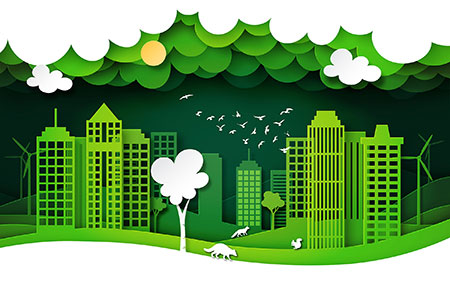The myriad species inhabiting our cities can help shape our designs
By Jane Slade
 In November, I had the privilege of being invited to the first-ever Urban Wildlife Information Network Summit at the Lincoln Park Zoo in Chicago. The purpose was to bring together ecologists along with designers, architects and urban planners in order to better understand why ecological research is not brought into building and design practices more often. This article is largely inspired by my experience with this community of changemakers in search of a more symbiotic relationship between humans and wildlife.
In November, I had the privilege of being invited to the first-ever Urban Wildlife Information Network Summit at the Lincoln Park Zoo in Chicago. The purpose was to bring together ecologists along with designers, architects and urban planners in order to better understand why ecological research is not brought into building and design practices more often. This article is largely inspired by my experience with this community of changemakers in search of a more symbiotic relationship between humans and wildlife.
We tend to think of wildlife as being elsewhere, somewhere out in the world in the hypothetical distance, far from us. Today, over half of the world population lives in cities, and this is only expected to increase with time. As the dominant species in urban environments, we are often surprised when we see a raccoon, coyote, turkey or hawk. Yet, these animals, among many others, inhabit urban environments right along with us. Moreover, urban areas were developed in regions of the planet that were convenient and valuable to humans, and often these same areas are critical for wildlife and the flow of ecosystems. By continuing on with the conveniently naïve idea that wildlife is somewhere else, we are in effect excluding wildlife within our design principles and practices for urban environments.
The study of urban wildlife is a developing scientific field, and holds immense promise and opportunity to uncover sustainable strategies to live more symbiotically with wildlife. Proximity offers a closer vantage to see and understand our impact. Until recently, studies of urban wildlife often focused upon a specific species in a specific city. To broaden understanding and address the complexities of ecosystems, a research network across cities was created, the Urban Wildlife Information Network.
Originating in Chicago, the Urban Wildlife Information Network (UWIN) is a growing group of scientists in more than 20 cities in North America. Data is collected via transects, or series of cameras cutting through critical urban locations for wildlife. Photographs of wildlife are tagged and then statistically analyzed to understand what species are present, how they behave and interact, and how species circulate through urban areas. This data is collected and shared across cities, creating a deeper understanding of environmental patterns.
One of the benefits of this modern research tool is that photographic research offers naturally cross-disciplinary information, showing the cross-section of many industries and their aggregate impact upon wildlife in tangible detail. Recent studies from the analysis of thousands of photographs have determined changes in animal behaviors and relationships due to urbanization, from the socioeconomic factors of per capita income linked to coyote colonization,1 to changes in predator-avoidance of the eastern cottontail and white-tailed deer from coyote.2 Furthermore, the design of green spaces in urban areas, as conceived by humans, alters the ability of certain species to colonize.3
How can the lighting industry use this scientific research to become better? Collaboration and dialogue across disciplines are direly needed to support sustainable innovation. These photographic studies offer a lens within ecosystems and a chance to change our design process. From cross-disciplinary understanding, there is opportunity for cross-disciplinary approaches. Perhaps it is understanding socioeconomic conditions while knowing the habitat preferences of a species. New combinations of information types foster new solutions for sustainable building practices.
In addition, the lighting industry is a salient example of the need to create a dialogue of best practices with people outside of our industry. Unfortunately, it is all too easy to disturb wildlife, as a single light fixture has the ability to create light pollution up to 120 miles away.4 Urbanized environments shine far beyond their borders, obstructing darkness, triggering circadian rhythms and blinding wildlife from a map of the stars.
Through cross-disciplinary conversation we can begin to deepen general awareness about light pollution. One obstacle to light pollution is the simple fact that the term itself does not elicit the same amount of alarm as other types of pollution, like global warming or the plastic islands in our oceans. To the untrained ear the term sounds bothersome, but not so much harmful. For this reason, lighting is not commonly thought of as a menace to wildlife, though it should be. In fact, the general public may be overlooking a major environmental shift regarding the illumination of our Earth at all times. The natural cycle of light is critical to balanced ecosystems.
Taking inspiration from our ecologist counterparts, we must also experiment with lighting installations. Our industry possesses a massively underutilized tool: lighting controls. (It should be noted that the very term controls implies that we have not been in control of lighting.) Yet, controls offer an unprecedented ability to light for human activity and reduce impact upon wildlife within one lighting installation. In the past, we might have been severely restricted to making any changes after a lighting design was installed. Now we have the ability to take one installation and make nearly infinite changes. Moreover, we can rapidly experiment and use this tool to become smarter. From changing lighting strategies during peak migration to turning lights out completely, controls are a vehicle to discover new methods in living more symbiotically with wildlife.
Recently, the 2019 landmark UN report on climate change stated that we are facing a mass extinction of up to 1 million species in the coming decades and that humans have “severely altered” 75% of the terrestrial environment.5 As an industry, we need to critically reflect upon our role in climate change and how we can improve. Ecosystems are far too complex to be working apart from one another. Through collaboration, research and incorporating the needs of wildlife within urban design, we can teach ourselves how to live in greater balance with all living things.
References
1 Magle, S. B., E. W. Lehrer, and M. Fidino. 2016. Urban mesopredator distribution: examining the relative effects of landscape and socioeconomic factors. Animal Conservation, 19: 163-175.
2 Gallo, T., Fidino, M., Lehrer, E. W., Magle, S. 2019. Urbanization alters predator avoidance behaviors. Journal of Animal Ecology.
3 Gallo, T., Fidino, M., Lehrer, E. W., and Magle, S. B. 2017. Mammal diversity and metacommunity dynamics in urban green spaces: implications for urban wildlife conservation. Ecological Applications, 27: 2330–2341.
4 Model Lighting Ordinance. (n.d.). Retrieved March 27, 2018, from http://www.darksky.org/our-work/public-policy/mlo/. User’s Guide, Page 4.
5 UNITED NATIONS Climate Change – Summit 2019. (n.d.). Retrieved from https://www.un.org/en/climatechange/reports.shtml

